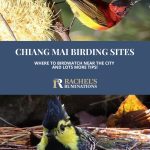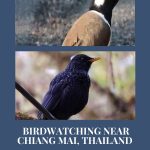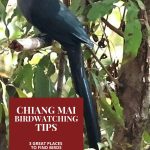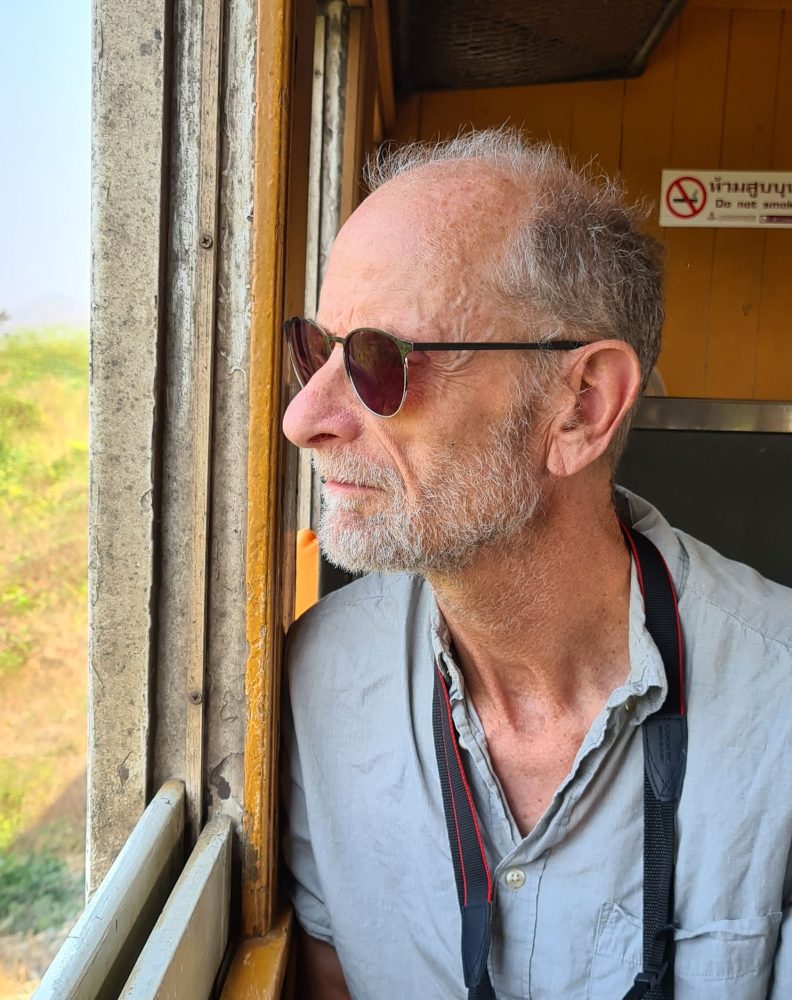Where to go birdwatching near Chiang Mai, Thailand
By Albert Smith
In February 2024, my wife Rachel and I spent a month in Chiang Mai, in northern Thailand. I was a couple of months into retirement, so while she was mostly working, I was able to wander about and explore the city, but also to revive a hobby of mine that I haven’t been able to do for some time: birdwatching. I brought binoculars and a 400mm camera lens for the occasion, and looked in my travel guide to Thailand to find out where to go birdwatching near Chiang Mai. Two locations came up: Doi Inthanon National Park and Doi Suthep National Park. But I ended up birdwatching in three places.
Disclosure: This article contains affiliate links. If you click on one and make a purchase, I (Rachel) will receive a small commission. This will not affect your price.

Doi Inthanon National Park
So I did some more research on the internet and discovered that there are several tour companies that offer birdwatching tours to Doi Inthanon National Park. Doi Inthanon is home to Thailand’s highest mountain, making it a popular birdwatching location. It’s a big enough park that it’s easy to get away from crowds. The tours pick you up at five in the morning and drive you to the top of the park, taking about two hours so you can start birdwatching at around 7 am. English-speaking guides are provided, who presumably know what different species you can expect in the different areas of the park.
My day of birdwatching in Doi Inthanon
I say “presumably” because I did not take a guided tour. I usually do not like group tours as they prevent you from exploring the trails at your own pace. You might not get the time to wait for the resident species of birds to appear and then try to capture them in a photo. So, again with some research, I found this interesting site about birding in Doi Inthanon National Park. This site gives a lot of information about the park, the trails and the different areas for birdwatching in the park.
I rented a car (1350 bhat for the day) and started off at 5:30 in the morning. It took me about two hours to get to the top of the park, so I was able to start my birdwatching at around 7:30 am. As I stepped on the summit trail I almost immediately heard a loud bird that was posing for me on a branch: a Blue Whistling Thrush.
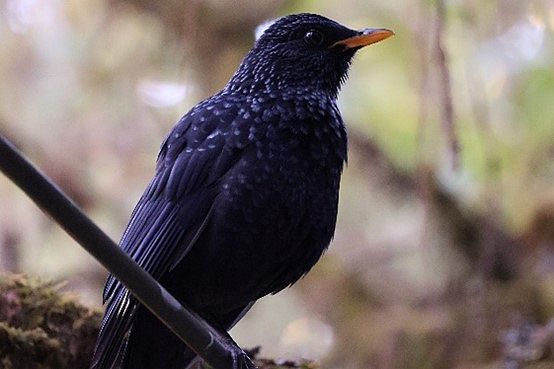
Not much later I heard something rustling on the ground and spotted a pair of Roufus-Throated Partridges making their way through the undergrowth. I heard quite a few other birds and saw them flying from one branch to another. But they didn’t perch long enough in the same spot to take a picture or identify them. A local guide might have been helpful here.
Next, I moved on to another part of the park and took a side road that went up to where the Kew Mae Pan trail starts. While the hilltop was pretty busy with other tourists – mostly not birdwatchers – this side road was completely devoid of any cars or motorbikes. At the parking lot with a view over the valley, I was completely alone and enjoyed the view for a while, waiting to see if I could spot any birds flying by. It was here that I saw the most beautiful bird of the day: a Crimson Sunbird. What a magnificent little creature!
Driving back, I stopped at the Inthanon Lady’s Slipper Orchid Conservation Project, which is within the boundaries of Doi Inthanon National Park, and walked the Lichen Nature Trail around the pond. The project has a wonderful orchid garden with many incredibly beautiful flowers. There were birds there too and I was able to photograph the Yellow-Cheeked Tit, amongst others.
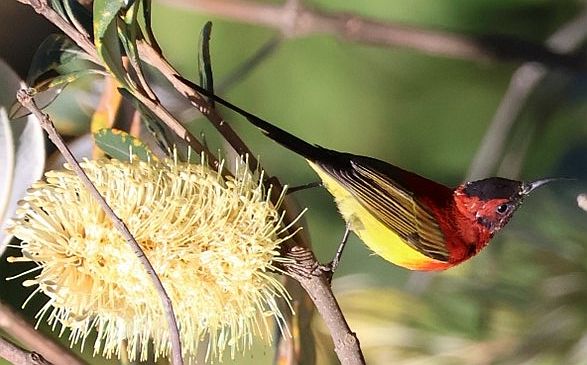
Over 500 bird species are present in Doi Inthanon. With enough time, you have a good chance of spotting lots of other birds: Green-Tailed Sunbirds, White-Capped Redstart, Black-Headed Woodpecker, Himalayan Shortwing, Niltavas, Woodpigeons, and many others. Which ones you see will depend on which habitats you visit: the highest point in Thailand at the summit, with its evergreen forest, or lower down on the mountain, with its river habitats or deciduous forest. Click here to see and print out a checklist.
Other things to see in Doi Inthanon
I could have spent more time to visit the various different waterfalls were it not for taking a wrong turn in the road, which led me away from the park. By the time I noticed my mistake I was well on my way to Chiang Mai. So I decided to continue along the wonderfully curvy road through the woods, a much more interesting road than the one I took going into the park.
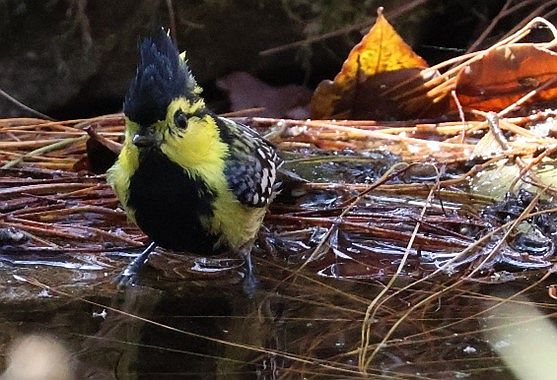
Below are some other things to see within Doi Inthanon Park. The waterfalls will vary in size depending on the time of the year. May to November is the rainy season, when waterfalls will be at their best, but the weather might not.
- Siriphum Waterfall: This is a long waterfall down a cliff, about 100 meters tall, with a second waterfall nearby down the same cliff. The best views are from the road, but walking closer will probably get you more birds to spot.
- Wachirathan Waterfall: Tumbling down a series of steps of a cliff, this waterfall is about 80 meters high. It is easy to get to, so it might be more crowded than the others in the middle of the day. Go early morning or late afternoon for less of a crowd. Walk the short trail, which might get you away from the crowds enough to see some birds.
- Mae Klang Waterfall: Shorter than Siriphum and Wachirathan, this waterfall is pretty nevertheless, especially in the wet season, flowing down more rocky steps. The path there from the parking area is less than half a kilometer long.
- Mae Ya Waterfall: There are different estimates of how high this one is. If you count the many steps it takes down the hillside, you can see it as over 200 meters high, which makes it the highest waterfall in Thailand. The main section of the falls is closer to 40 meters. This waterfall is particularly pretty because it is quite wide and its biggest section cascades prettily in a triangular form as it fans out on its way down stone steps. The walk to the falls isn’t long, which means it gets crowded here, much like Wachirathan. Go early in the morning or late in the afternoon when the crowds thin and the birds will be more visible.
- The Hydrangea Garden. This garden isn’t far from the orchid project, but apparently the road to it is rough, so only visit with a four-wheel-drive car.
- Pagoda Noppamethanedon and Pagoda Nopphonphusiri. These two pagodas are right next to each other within the park. One pagoda is for women, the other for men. The garden around it is pleasant, with pretty views – if it’s not fire season.
If you’ll be spending any time in Bangkok, take a look at these articles as well:
Doi Suthep National Park
Doi Suthep is the mountain you can see from the city of Chiang Mai, so it’s much closer, right on the outskirts of the city. This was the last park I visited. Unfortunately I was not able to do much proper bird watching there due to the limited amount of time we could spend. My wife and I were there to visit Wat Phra That Doi Suthep, an important and extensive temple on top of the hill.
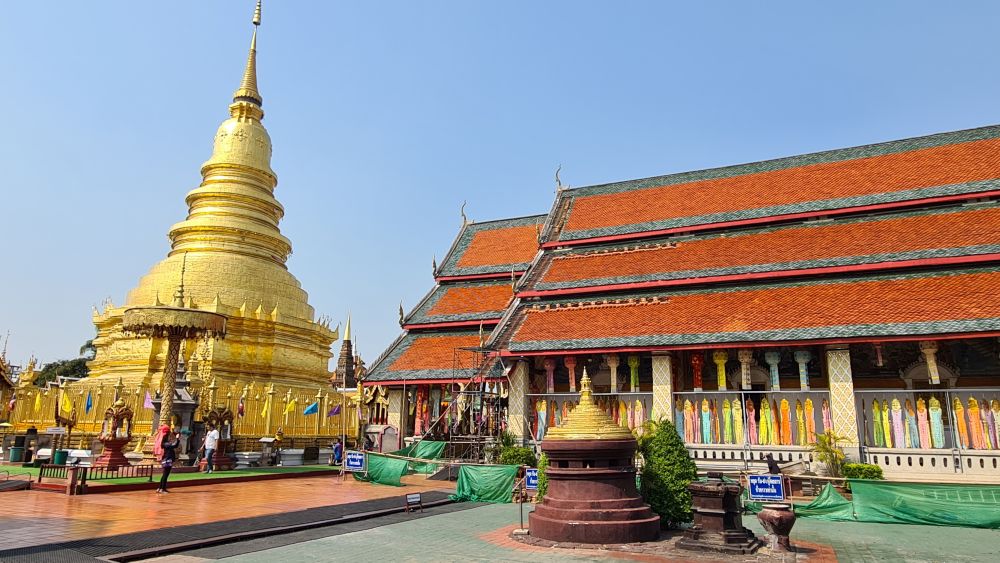
It is well worth seeing. The mountain is covered in forest, so there is plenty of birdwatching to do, but we didn’t have time to go walking in the woods. In the short time we were there, though, I spotted the Black-Crested Bulbul and also saw the Green Cochoa, but it was in flight so I wasn’t able to get a photo. To do some proper birdwatching, however, you should wander some of the trails in this park.
Like at Doi Inthanon, more than 500 different species live in this park. It’s a good location to spot a Great Tit, Red-Whiskered Bulbul, White-Browed Shortwing, Blue-Bearded Bee-Eater, and a whole range of various laughingthrushes, barbets, bulbuls, eagles, nuthatches, and many more. Here is a complete checklist.
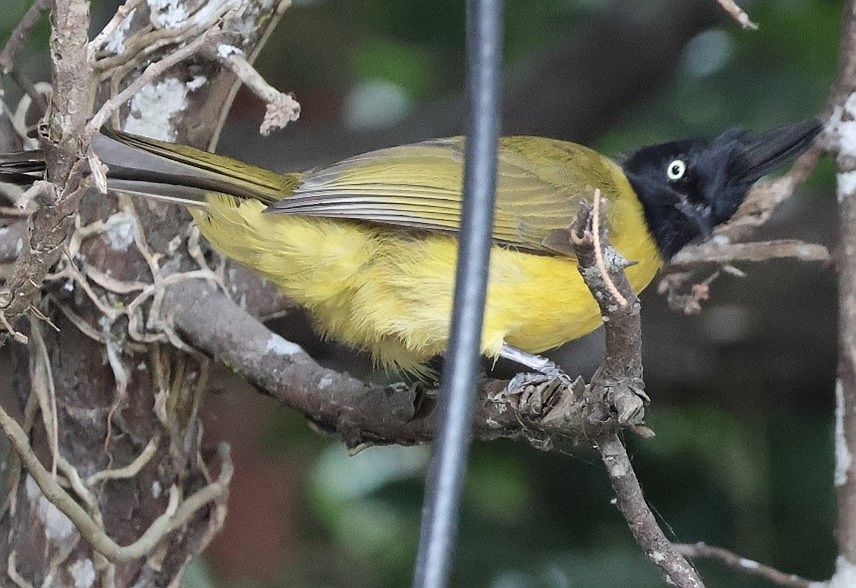
Other sights in Doi Suthep
Besides just taking a walk in the woods to see what birds you can spot, Doi Suthep has other attractions within its borders:
- Huay Keaw Waterfall: This is a rather small and gradual waterfall but offers some good birdwatching – when it’s not overrun by local visitors. It’s popular because it’s at the base of the mountain and relatively close to Chiang Mai. Climb the path to the top of the falls to get away from the people. The waterfall may dry up in the dry season.
- Mon Tha Than Waterfall: This waterfall in three levels is small but pretty. Like Huay Keaw, it is popular with local daytrippers. There’s a path up the waterfall, but most people won’t go past the second level, so for a little peaceful birdwatching, go up the top. It’s purported to be a good place for birding.
- Khun Chang Khian: This mountain village is a good place to use as a base for birdwatching. During the short cherry-blossom season, though, it gets crowded.
- Wat Phra That Doi Kham: This temple on a hill on the edge of the National Park has a 17-meter-high sitting Buddha.
- Queen Sirikit Botanic Garden: This garden is on the far side of the mountain from Chiang Mai. There are walking trails through the garden and sections with different themes, like a rainforest and a cactus garden. There’s also a canopy walk. Aim to get there when they open, usually at 8:30, and you should be able to see plenty of birds.
Both national parks – Doi Suthep and Doi Inthanon – are covered in deciduous forest at lower levels and pine forest at higher levels, offering habitats for a wide variety of the birds of Thailand.
Use the map below to book accommodations in Chiang Mai:
If you’d rather be outside of the city, find accommodations nearer to Doi Inthanon.
Huay Tueng Thao Reservoir
Aside from Doi Inthanon and Doi Suthep, there are also a couple of other places that you can visit that offer good birdwatching. One morning, I rented a bicycle and cycled (about 45 minutes to an hour) to Huay Tueng Thao Reservoir. It’s a really beautiful site where you can spot birds at the waterside and in the woods surrounding the reservoir. It also has an open watchtower that you can climb to observe birds. I would say that you are sure to see the Red-Wattled Lapwing and the Javan Pond Heron. I also spotted the Greater Racquet-Tailed Drongo and a Green-Billed Malkkoha.

You also might spot a Rufous-Winged Buzzard or various magpies, barbets or flycatchers, among others, either near the water or in the nearby rice paddies.
This place is very popular, especially on weekends, when locals will go there to enjoy a beach day and some swimming and various other activities offered on the reservoir or nearby. There’s a zipline, for example, and a sculpture garden, with large figures of various animals made with leftover rice straw. Restaurants on the shores of the reservoir are quite busy on weekends and holidays. Go early in the morning on a weekday for birding. It’s a good spot if you have little time because it’s so close to the city.
There are more forested areas further from Chiang Mai that I didn’t visit: Doi Pha Hom Pok National Park, Doi Ang Khang, and Doi Chiang Dao are in the mountainous regions to the north of Chiang Mai.
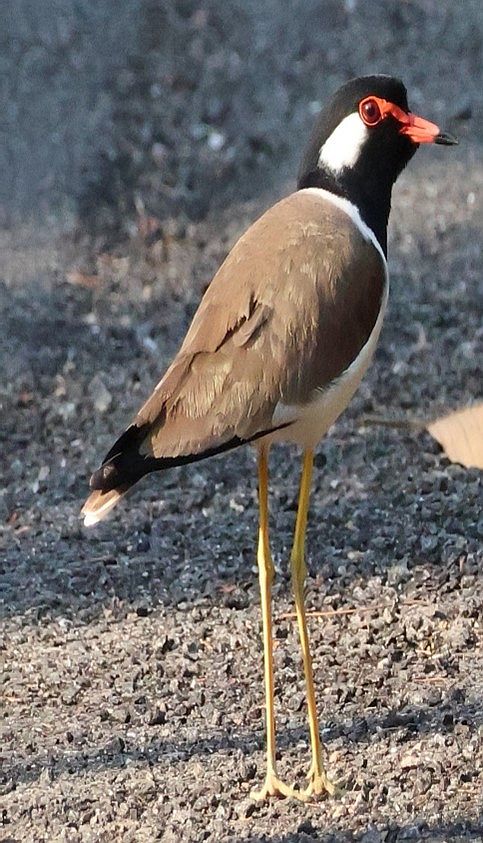
Getting to the birdwatching sites
Doi Inthanon
Unless you’re a fanatical cyclist, don’t try cycling up the mountain. Instead, rent a car. Going by tuktuk or a little motorbike would be difficult and slow. By car, the drive to the entrance to the park will take 1.5-2 hours from Chiang Mai: it’s 88 kilometers (54 miles) away. You can also sign up for a birding tour and leave the driving to someone else, or hire a taxi and driver (or a red taxi or songtaew dang) for the day. Make sure to negotiate a price first and make it clear you want the driver to wait for you.
Yellow songtaews serve as buses up the mountain too, taking you from Chiang Mai Gate Market up to Chom Thong. There you can take another songtaew into the park. The problem with this is that they take longer, and they often won’t leave until the vehicle is full, which means you’ll miss the early-morning birding.
Doi Suthep
Again, driving is best, using a car or motorcycle, though if you are comfortable enough on a motorbike, you could do that. The easiest options are to rent a car or take a taxi. The drive takes about a half-hour. You could hire a songthaew or take one of the regular ones that ferry people up to Wat Phra That Doi Suthep. They leave from nearby the zoo, but again, they may wait to fill up before they leave. At the temple you can walk up the long staircase (300+ steps) lined with long snake carvings called naga, or take a funicular.
Huay Tueng Thao Reservoir
As I mentioned before, it’s about 45 minutes to an hour by bike from Chiang Mai to the reservoir. Otherwise, like with the other destinations, your best bets are renting a car or taking a taxi.
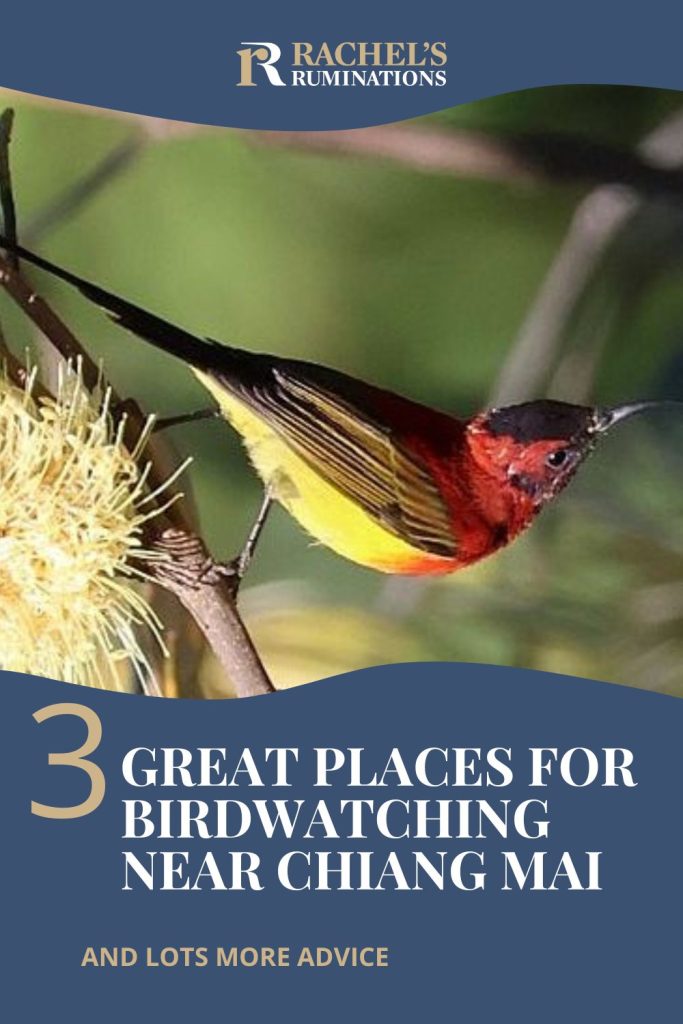
Tips for birdwatching near Chiang Mai
It goes without saying that early in the morning is the best time to go birdwatching. If you visit Doi Inthanon National Park, I would advise not to start at the top of the mountain. Do some of the lower sites mentioned on the Thai Birding website first. The top of the mountain is very chilly in the early hours of the day and birds can be observed a bit later up there.
At Huay Tueng Thao Reservoir, look for the watchtower first thing. This will increase the chance that you will spot birds higher up in the trees. I noticed the watchtower late in the morning when fewer birds were active.
The high season, which is about November-February, means more tourists from outside the country. But it also means that the forests and waterfalls are at their lushest because the high season includes the end of the wet season and beginning of the dry season. Later in the dry season the air quality declines because of farmers burning their fields. The views will be hazier and, on the days of very low air quality, it might not be wise to go on hikes.
If you’re going birdwatching near Chiang Mai, keep an eye on the temperature too. It gets quite hot starting in January, with average high temperatures in April of 34°C (93F), Yet we experienced temperatures of around 40°-42°C (104°-108°F) in early March. The coolest time of year is December, with an average high of 28°C (82°F). If you’re going up one of the mountains, though, particularly Doi Inthanon, bring a light jacket. At the peak – 2,565 meters or 8415 feet – it is very chilly in the mornings.
In the dry season, the waterfalls will be less dramatic, and some might dry up altogether. That doesn’t mean that you shouldn’t visit them for birdwatching purposes. For one thing, you’ll find fewer tourists. For another, if you follow the small stream up the waterfall, you could find a lot of bird activity around the remaining small pools.
Have you done any birdwatching near Chiang Mai? Where did you go? And would you recommend it?
Text and photos provided by Albert Smith. Albert is a retired dentist and professor and the husband of Rachel Heller, the owner of this website.
My travel recommendations
Planning travel
- Skyscanner is where I always start my flight searches.
- Booking.com is the company I use most for finding accommodations. If you prefer, Expedia offers more or less the same.
- Discover Cars offers an easy way to compare prices from all of the major car-rental companies in one place.
- Use Viator or GetYourGuide to find walking tours, day tours, airport pickups, city cards, tickets and whatever else you need at your destination.
- Bookmundi is great when you’re looking for a longer tour of a few days to a few weeks, private or with a group, pretty much anywhere in the world. Lots of different tour companies list their tours here, so you can comparison shop.
- GetTransfer is the place to book your airport-to-hotel transfers (and vice-versa). It’s so reassuring to have this all set up and paid for ahead of time, rather than having to make decisions after a long, tiring flight!
- Buy a GoCity Pass when you’re planning to do a lot of sightseeing on a city trip. It can save you a lot on admissions to museums and other attractions in big cities like New York and Amsterdam.
- Ferryhopper is a convenient way to book ferries ahead of time. They cover ferry bookings in 33 different countries at last count.
Other travel-related items
- It’s really awkward to have to rely on WIFI when you travel overseas. I’ve tried several e-sim cards, and GigSky’s e-sim was the one that was easiest to activate and use. You buy it through their app and activate it when you need it. Use the code RACHEL10 to get a 10% discount!
- Another option I just recently tried for the first time is a portable wifi modem by WifiCandy. It supports up to 8 devices and you just carry it along in your pocket or bag! If you’re traveling with a family or group, it might end up cheaper to use than an e-sim. Use the code RACHELSRUMINATIONS for a 10% discount.
- I’m a fan of SCOTTeVEST’s jackets and vests because when I wear one, I don’t have to carry a handbag. I feel like all my stuff is safer when I travel because it’s in inside pockets close to my body.
- I use ExpressVPN on my phone and laptop when I travel. It keeps me safe from hackers when I use public or hotel wifi.


